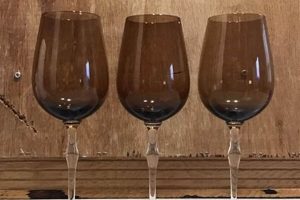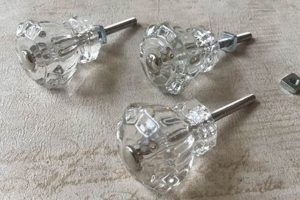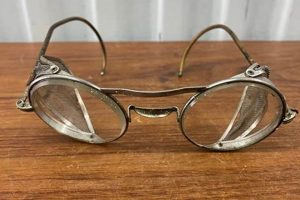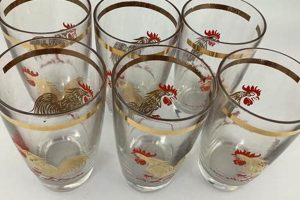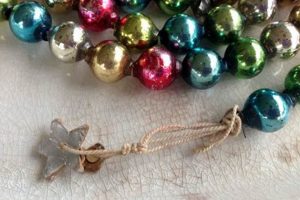Opaque white glassware, reminiscent of porcelain, gained popularity in the late 19th century and continued its appeal throughout the 20th century. Often featuring intricate designs and textures, these items were produced in a wide variety of forms, including plates, bowls, serving pieces, and decorative objects. For example, a “Waffle” pattern compote exemplifies this style’s characteristic texture and form.
This type of glassware holds significant value for collectors due to its historical significance, aesthetic appeal, and relative scarcity of certain patterns and manufacturers. The durable nature and timeless elegance contribute to its enduring popularity. Furthermore, these items offer a tangible link to past generations and decorative styles, providing insight into the design sensibilities of bygone eras.
The following sections will delve into the history of this glassware, discuss prominent manufacturers, explore common patterns, and provide guidance on identifying and valuing these desirable collectibles.
Tips for Identifying and Collecting Vintage Opaque White Glassware
Acquiring and preserving these items requires a discerning eye and a foundational understanding of its characteristics. The following tips provide guidance for identifying authentic pieces and building a valuable collection.
Tip 1: Examine for Maker’s Marks: Reputable manufacturers often included identifying marks on their products. These marks can provide valuable clues to the piece’s origin and age. For instance, look for the “Fenton” logo or the “Westmoreland” mark on the underside of bowls or plates.
Tip 2: Analyze the Color and Opacity: Authentic pieces typically exhibit a consistent, even opacity. Variations in color or a translucent appearance may indicate reproduction or lower-quality glass. Genuine examples display a rich, creamy white hue.
Tip 3: Inspect the Mold Marks and Seams: The presence and quality of mold marks offer insights into the manufacturing process. Older pieces often exhibit subtle imperfections, while modern reproductions may have cleaner, more defined seams. The location and style of the seams can also provide clues to the piece’s age.
Tip 4: Study Pattern Characteristics: Familiarize yourself with common patterns, such as “Grape Arbor” or “Hobnail,” and their variations. This knowledge aids in identifying specific manufacturers and detecting inconsistencies that may suggest a reproduction. Accurate pattern identification increases value.
Tip 5: Check for Damage and Repairs: Carefully inspect pieces for chips, cracks, or repairs. Even minor damage can significantly reduce the value. Use a magnifying glass to detect hairline fractures or subtle restorations.
Tip 6: Consider the Weight and Feel: Genuine pieces often have a substantial weight and a smooth, almost velvety feel. Reproductions may feel lighter or have a rougher texture. The overall weight is an indicative quality in authentic examples.
Tip 7: Research Historical Context: Understanding the historical context and production methods of this glassware enhances the appreciation and value of a collection. Researching manufacturers and popular patterns expands knowledge and expertise.
By applying these tips, collectors can make informed decisions, avoid costly mistakes, and build collections of genuine value and historical significance.
With this knowledge in hand, the next section will discuss valuation factors and preservation strategies.
1. Opacity Consistency
Opacity consistency stands as a critical indicator of the quality and authenticity. Variations in opacity, manifesting as streaks, uneven coloration, or translucent areas, typically denote lower-quality glass or reproductions. Authentic items from renowned manufacturers exhibit a uniform, dense opacity throughout the piece. For example, a piece produced with inconsistent opacity is often attributed to newer mass productions, contrasting with the meticulously crafted originals. The cause of inconsistencies often stems from variations in the raw material mixtures or fluctuations during the molding process.
The importance of opacity consistency extends beyond mere aesthetics; it provides insights into the manufacturing techniques employed and the adherence to quality control standards. The even distribution of opacifiers, crucial to achieving a consistent, porcelain-like appearance, demonstrates the manufacturer’s expertise. The practical significance lies in its ability to differentiate genuine antique pieces from modern imitations, influencing valuation and collectibility. Inconsistencies detract from the visual appeal and, more significantly, compromise the perceived value of the item.
In conclusion, opacity consistency offers a valuable criterion for identifying and evaluating. Recognizing the subtle nuances in opacity enables informed purchasing decisions and enhances appreciation for the craftsmanship inherent in authentic pieces. The challenge resides in discerning minor variations requiring careful visual inspection and familiarity with manufacturing techniques. Understanding this connection is foundational for the responsible preservation and valuation of these historical objects.
2. Pattern Intricacy
Pattern intricacy functions as a key determinant of value and aesthetic appeal within the realm of collectible opaque white glassware. The level of detail present in a piece’s design directly correlates with its manufacturing complexity and, consequently, its desirability among collectors. For instance, elaborate floral motifs, detailed figural representations, or complex geometric arrangements require skilled artisans and sophisticated mold-making techniques. These factors elevate the pieces beyond mere functionality to the level of artistic expression. The “Grape Arbor” pattern, with its raised grape clusters and intricate vine details, exemplifies this connection, showcasing how a complex pattern enhances both the visual impact and the perceived value of the dish.
Furthermore, the precision and clarity of pattern execution offer insights into the manufacturing period and the quality control standards of the producing company. Crisp, well-defined patterns, free from blurring or imperfections, often indicate a higher level of craftsmanship and suggest a piece originating from a reputable manufacturer during its prime production years. Conversely, poorly defined patterns may suggest reproductions or pieces produced during periods of cost-cutting or decreased quality control. The practical application of this understanding lies in its ability to differentiate authentic pieces from imitations, guiding collectors in making informed purchasing decisions. A side-by-side comparison of a genuine Fenton piece with a reproduction often reveals subtle differences in pattern sharpness and detail.
In summary, pattern intricacy serves as a significant indicator of quality, authenticity, and historical value. While appreciating this feature enhances the enjoyment of collecting, it also presents challenges in identifying subtle pattern variations and discerning genuine pieces from reproductions. Understanding the nuances of pattern design, manufacturing techniques, and historical context is paramount for anyone seeking to build a valuable and authentic collection. The emphasis on pattern complexity, therefore, reinforces the importance of detailed observation and informed research in the pursuit of quality opaque white glassware.
3. Manufacturer Markings
Manufacturer markings represent a critical element in the identification, authentication, and valuation of opaque white glassware. These marks, often discreetly placed on the underside or within the design, provide verifiable evidence of origin and historical context. The presence, absence, or characteristics of these markings directly influence a piece’s collectibility and market value.
- Identification and Authentication
Manufacturer markings serve as primary tools for identifying the producing company and authenticating the piece. Marks such as the Fenton logo, the McKee Glass Company’s keystone, or the Westmoreland Glass Company’s “WG” emblem offer irrefutable proof of origin. These markings enable collectors to differentiate genuine articles from unmarked reproductions or similar designs produced by other manufacturers.
- Dating and Period Attribution
Changes in manufacturer markings over time provide clues to the period of production. Companies frequently modified their logos or added date codes to indicate when an item was manufactured. For example, a specific iteration of the Fenton logo can narrow the production window to within a few years, increasing the accuracy of dating and informing the piece’s historical significance.
- Rarity and Value Assessment
The presence of a particular manufacturer’s mark can significantly impact a piece’s rarity and subsequent value. Pieces from manufacturers known for limited production runs, specialized designs, or discontinued lines command higher prices in the collectors’ market. Certain marks associated with highly sought-after patterns or color variations further enhance the perceived value and desirability.
- Preventing Misidentification and Fraud
Understanding manufacturer markings is essential for preventing misidentification and guarding against fraudulent claims. Reproductions often lack authentic markings or bear imitation marks intended to deceive buyers. A thorough examination of the mark, coupled with knowledge of its historical variations, helps ensure the authenticity of a purchase and protects collectors from investment losses.
In conclusion, manufacturer markings represent a crucial facet in the study and collection of opaque white glassware. These markings serve as verifiable identifiers, dating tools, value indicators, and safeguards against fraud. A deep understanding of these marks is essential for anyone seeking to acquire, preserve, or appreciate the historical and artistic significance of these objects.
4. Edge Detailing
Edge detailing, in the context of collectible opaque white glassware, constitutes a significant element influencing aesthetic appeal, perceived value, and authenticity assessment. The treatment of the edges of these dishes serves as a distinctive characteristic, reflecting both the design sensibilities of the era and the manufacturing capabilities of the producing company.
- Scalloping and Crimping
Scalloping and crimping techniques, often employed to create decorative edges, add visual interest and complexity to the overall design. These features, achieved through specialized molds or manual manipulation, reflect the craftsmanship inherent in vintage pieces. For instance, a delicately scalloped edge on a compote exemplifies this level of detail. The uniformity and precision of these features are indicative of higher-quality manufacturing processes.
- Beading and Ribbing
Beaded or ribbed edges provide a tactile dimension to opaque white glassware, enhancing both visual appeal and structural integrity. These raised elements, often arranged in symmetrical patterns, create a play of light and shadow, contributing to the piece’s aesthetic depth. The presence of consistent and well-defined beading or ribbing signifies attention to detail during the manufacturing process.
- Color Accents and Gilding
The application of color accents or gilding to the edges of vintage opaque white glassware represents a further refinement of design. The addition of gold or contrasting colors highlights the contours and enhances the overall visual impact. This decorative treatment, often applied by hand, indicates a higher level of craftsmanship and contributes to the piece’s perceived value and collectibility.
- Smooth vs. Ground Edges
The finish of the edge, whether smooth or ground, provides insights into the manufacturing techniques and intended use of the dish. Smooth edges, typically achieved through fire polishing, offer a refined and elegant appearance. Ground edges, often found on utilitarian pieces, provide a more durable and functional surface. The type of edge finish is indicative of the piece’s original purpose and target market.
The nuances of edge detailing provide valuable clues for identifying and authenticating vintage opaque white glassware. The variations in scalloping, beading, color accents, and edge finish reflect the design trends and manufacturing capabilities of different eras and manufacturers. As such, a keen understanding of these characteristics enhances a collector’s ability to assess quality, determine authenticity, and appreciate the artistry inherent in these timeless collectibles.
5. Glass Thickness
Glass thickness in vintage opaque white glassware serves as a significant indicator of manufacturing techniques, intended use, and durability. A thicker gauge often implies a more robust construction, designed for utilitarian purposes or to withstand the stresses of elaborate molding. For example, a serving bowl intended for heavy use might exhibit a substantial thickness, while a delicate bonbon dish is likely to possess thinner walls. Deviations from expected thickness for a given pattern or manufacturer can suggest reproductions or pieces intended for a different market segment. The thickness impacts the piece’s resilience to chipping and cracking, directly influencing its long-term condition and collectibility.
Variations in thickness also reflect evolving glassmaking technologies. Early hand-pressed pieces often display greater thickness variations due to the inherent limitations of manual production. As mechanized processes advanced, more uniform thickness became achievable, reflecting improved control over glass distribution. Examining the cross-section of a broken edge, if available, can reveal valuable clues regarding the manufacturing process and potentially assist in dating the item. For instance, a consistent thickness throughout a piece suggests machine production, whereas noticeable variations point towards hand-pressing or blowing techniques. This information is crucial for informed purchasing decisions.
In summary, glass thickness offers a tangible measure of quality and manufacturing practices in vintage opaque white glassware. While assessing thickness necessitates a practiced eye and familiarity with specific patterns and manufacturers, it provides valuable insights into a piece’s origin, intended use, and potential durability. Recognizing the implications of glass thickness empowers collectors to make informed judgments and appreciate the nuanced details that distinguish authentic vintage pieces from modern reproductions. The challenge lies in developing the tactile and visual sensitivity required to accurately assess thickness and correlate it with other identifying characteristics.
6. Era Specificity
Era specificity holds considerable importance in the identification, valuation, and appreciation of collectible opaque white glassware. Production techniques, design sensibilities, and popular patterns shifted significantly across different eras, resulting in discernable characteristics unique to specific periods. Understanding these nuances is critical for accurate attribution and informed collecting. For example, Art Deco-era pieces often display streamlined geometric designs, contrasting sharply with the floral motifs prevalent in Victorian-era examples. The availability of certain opacifiers and coloring agents also varied over time, leading to subtle but detectable differences in color and opacity between pieces manufactured in different periods. Identifying era-specific characteristics allows collectors to differentiate genuine articles from later reproductions or pieces misattributed to incorrect time periods. This information is fundamental for accurate appraisal and historical contextualization.
The impact of era specificity extends beyond mere aesthetics, influencing practical considerations such as rarity and market value. Pieces produced during periods of limited production or significant historical events often command higher prices due to their scarcity and associated cultural significance. For instance, glassware manufactured during wartime may exhibit utilitarian designs reflecting resource limitations, making them distinctive and sought-after by collectors. Furthermore, the popularity of certain patterns and forms waxed and waned over time, creating fluctuations in availability and desirability. Awareness of these temporal trends enables collectors to strategically focus their efforts on acquiring pieces aligned with their specific interests and investment goals. For example, understanding that a particular manufacturer only produced a specific pattern for a short duration during a specific decade greatly impacts its value.
In conclusion, era specificity is an indispensable component in the study and appreciation of vintage opaque white glassware. Recognizing the distinct characteristics associated with different periods enables accurate identification, informed valuation, and a deeper understanding of the historical context in which these objects were created. While discerning these subtle differences requires diligent research and careful observation, the rewards include enhanced collecting experiences and the preservation of valuable cultural heritage. The challenge lies in synthesizing knowledge of historical manufacturing techniques, design trends, and economic conditions to accurately interpret the evidence presented by each individual piece.
Frequently Asked Questions
The following section addresses common inquiries and misconceptions surrounding the identification, valuation, and care of vintage opaque white glassware. The aim is to provide clarity and informed guidance to collectors and enthusiasts.
Question 1: What are the primary distinguishing features between authentic vintage opaque white glassware and modern reproductions?
Authentic vintage pieces often exhibit subtle imperfections indicative of manual manufacturing processes, such as slight variations in thickness or minor mold marks. Modern reproductions typically display greater uniformity and precision, reflecting automated production techniques. Color consistency and the sharpness of molded details also serve as distinguishing factors.
Question 2: How does one accurately assess the value of a piece of vintage opaque white glassware?
Valuation depends on several factors, including rarity, condition, manufacturer, pattern, and overall desirability. Researching comparable sales data from reputable auction houses and antique dealers is crucial. Professional appraisal provides an objective assessment of value, considering current market trends and the piece’s specific attributes.
Question 3: What are the recommended methods for cleaning and preserving delicate vintage opaque white glassware?
Gentle hand washing with mild soap and lukewarm water is the preferred method. Abrasive cleaners or harsh chemicals should be avoided. Pieces should be dried thoroughly with a soft cloth and stored in a protected environment, away from direct sunlight and extreme temperature fluctuations.
Question 4: Are there specific manufacturers of vintage opaque white glassware that are more highly sought after by collectors?
Yes, certain manufacturers, such as Fenton, Westmoreland, and McKee, are particularly renowned for their quality and distinctive designs. Pieces bearing these manufacturers’ marks often command higher prices in the collectors’ market, particularly if they represent rare patterns or color variations.
Question 5: What steps can be taken to protect a collection of vintage opaque white glassware from damage or loss?
Secure display cabinets or shelving units minimize the risk of accidental breakage. Insuring the collection against theft, damage, or loss provides financial protection. Documenting the collection with photographs and detailed descriptions facilitates identification and recovery in the event of a loss.
Question 6: How can one identify potential reproductions or forgeries within the realm of vintage opaque white glassware?
Careful examination of manufacturer markings, pattern details, and glass quality is essential. Comparing the piece to known authentic examples and consulting with experienced collectors or appraisers helps detect inconsistencies. Suspiciously low prices or the absence of expected markings should raise red flags.
In summary, the acquisition, preservation, and appreciation of vintage opaque white glassware require diligent research, careful observation, and informed decision-making. Understanding the nuances of manufacturing techniques, design characteristics, and market dynamics is crucial for both novice and experienced collectors.
The subsequent section will explore advanced collecting strategies and resources for further study.
Vintage Milk Glass Dishes
This exploration has elucidated the multifaceted nature of opaque white glassware collecting. From identifying authentic pieces to appreciating the intricacies of era-specific designs and the importance of manufacturer markings, a thorough understanding of its nuances is essential. The assessment of glass thickness, edge detailing, and pattern complexity further enhances the collector’s ability to discern value and historical context.
The enduring appeal of vintage milk glass dishes stems from their inherent beauty, historical significance, and tangible connection to bygone eras. Continued research, careful preservation, and informed collecting practices will ensure that future generations can appreciate and learn from these artifacts of material culture. The responsibility of stewardship rests with those who recognize the value of these objects, securing their place in the narrative of design and craftsmanship.



